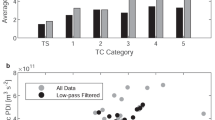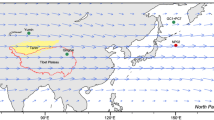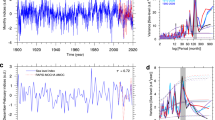Abstract
The dominant source of coupled ocean–atmosphere variability in the tropical Atlantic is the so-called Atlantic Meridional Mode1,2,3. This mode of variability is characterized by an interhemispheric gradient in sea surface temperatures and by oscillations in the strength of surface winds that cross the Equator, thereby reinforcing sea surface temperature anomalies1,2,3,4. The Atlantic Meridional Mode is thermodynamically damped and must receive external forcing to persist as observed3. However, it is not known which external forcing factors have excited the Atlantic Meridional Mode in the historical record. Here we present simulations with an ocean general circulation model that is forced by a record of surface radiation from anomalous dust concentrations in the atmosphere, reconstructed from a coral proxy and satellite retrievals. We show that the Atlantic Meridional Mode is excited by variability in African dust outbreaks on interannual to decadal timescales. Our analysis indicates that sea surface temperature anomalies resulting from the aerosol direct effect persist in time through the positive ocean–atmosphere feedback5 that defines the Atlantic Meridional Mode. We conclude that on interannual to decadal timescales, the state of the tropical Atlantic ocean is directly tied to dust emissions over West Africa, which in turn are linked to land-use change6,7,8.
This is a preview of subscription content, access via your institution
Access options
Subscribe to this journal
Receive 12 print issues and online access
$259.00 per year
only $21.58 per issue
Buy this article
- Purchase on Springer Link
- Instant access to full article PDF
Prices may be subject to local taxes which are calculated during checkout



Similar content being viewed by others
References
Chang, P., Ji, L. & Li, H. A decadal climate variation in the tropical Atlantic Ocean from thermodynamic air–sea interactions. Nature 385, 516–518 (1997).
Chiang, J. C. H. & Vimont, D. J. Analogous Pacific and Atlantic Meridional Modes of tropical atmosphere–ocean variability. J. Clim. 17, 4143–4158 (2004).
Vimont, D. J. Transient growth of thermodynamically coupled variations in the tropics under an equatorially symmetric mean state. J. Clim. 23, 5771–5789 (2010).
Xie, S-P. & Carton, J. A. in Earth’s Climate: The Ocean–Atmosphere Interaction (eds Wang, C., Xie, S-P. & Carton, J. A.) 121–142 (Geophys. Monogr. Ser., Vol. 147, AGU, 2004).
Xie, S-P. & Philander, S. G. H. A coupled ocean–atmosphere model of relevance to the ITCZ in the eastern Pacific. Tellus 46, 340–350 (1994).
Mahowald, N. M. Anthropocene changes in desert area: Sensitivity to climate model predictions. Geophys. Res. Lett. 34, L18817 (2007).
Mahowald, N. M. et al. Observed 20th century desert dust variability: Impact on climate and biogeochemistry. Atmos. Chem. Phys. Discuss. 10, 12585–12628 (2010).
Mulitza, S. et al. Increase in African dust flux at the onset of commercial agriculture in the Sahel region. Nature 466, 226–228 (2010).
Goudie, A. S. & Middleton, N. J. Desert Dust in the Global System (Springer, 2006).
Kaufman, Y. J. et al. Dust transport and deposition observed from the Terra-Moderate Resolution Imaging Spectroradiometer (MODIS) spacecraft over the Atlantic Ocean. J. Geophys. Res. 110, D10S12 (2005).
Evan, A. T. & Mukhopadhyay, S. African dust over the northern tropical Atlantic: 1955–2008. J. Appl. Meteorol. Climatol. 49, 2213–2229 (2010).
Evan, A. T., Vimont, D. J., Heidinger, A. K., Kossin, J. P. & Bennartz, R. The role of aerosols in the evolution of tropical North Atlantic Ocean temperature anomalies. Science 324, 778–781 (2009).
Foltz, G. R. & McPhaden, M. J. Impact of Saharan dust on tropical North Atlantic SST. J. Clim. 21, 5048–5060 (2008).
Foltz, G. R. & McPhaden, M. J. Trends in Saharan dust and tropical Atlantic climate during 1980–2006. Geophys. Res. Lett. 35, L20706 (2008).
Prospero, J. M. & Lamb, P. J. African droughts and dust transport to the Caribbean: Climate change implications. Science 302, 1024–1027 (2003).
Marshall, J., Adcroft, A., Hill, C., Perelman, L. & Heisey, C. A finite-volume, incompressible Navier Stokes model for studies of the ocean on parallel computers. J. Geophys. Res. 102, 5753–5766 (1997).
Marshall, J., Hill, C., Perelman, L. & Adcroft, A. Hydrostatic, quasi-hydrostatic, and nonhydrostatic ocean modeling. J. Geophys. Res. 102, 5733–5752 (1997).
Kalnay, E. et al. The NCEP/NCAR 40-year reanalysis project. Bull. Am. Meteorol. Soc. 77, 437–471 (1996).
Chang, P., Ji, L. & Saravanan, R. A hybrid coupled model study of tropical Atlantic variability. J. Clim. 14, 361–390 (2001).
Battisti, D. S., Sarachik, E. S. & Hirst, A. C. A consistent model for the large-scale steady atmospheric circulation in the tropics. J. Clim. 12, 2956–2964 (1999).
Rayner, N. A. et al. Global analyses of sea surface temperature, sea ice, and night marine air temperature since the late nineteenth century. J. Geophys. Res. 108, 4407 (2003).
Czaja, A., van der Vaart, P. & Marshall, J. A diagnostic study of the role of remote forcing in tropical Atlantic variability. J. Clim. 15, 3280–3290 (2002).
Vimont, D. J. & Kossin, J. P. The Atlantic meridional mode and hurricane activity. Geophys. Res. Lett. 34, L07709 (2007).
Moulin, C., Lambert, C., Dulac, F. & Dayan, U. Control of atmospheric export of dust from North Africa by the North Atlantic oscillation. Nature 387, 691–694 (1997).
Evan, A. T., Heidinger, A. K. & Knippertz, P. Analysis of winter dust activity off the coast of West Africa using a new 24-year over-water advanced very high resolution radiometer satellite dust climatology. J. Geophys. Res. 111, D12210 (2006).
Foltz, G. R. & McPhaden, M. J. 2006: The role of oceanic heat advection in the evolution of tropical North and South Atlantic SST anomalies. J. Clim. 19, 6122–6138 (2006).
Kossin, J. P. & Vimont, D. J. A more general framework for understanding Atlantic hurricane variability and trends. Bull. Am. Meteorol. Soc. 88, 1767–1781 (2007).
Evan, A. T., Dunion, J., Foley, J. A., Heidinger, A. K. & Velden, C. S. New evidence for a relationship between Atlantic tropical cyclone activity and African dust outbreaks. Geophys. Res. Lett. 33, L19813 (2006).
Evan, A. T. et al. Ocean temperature forcing by aerosols across the Atlantic tropical cyclone development region. Geochem. Geophys. Geosyst. 9, Q05V04 (2008).
Acknowledgements
Financial support for this work was provided by NOAA/CLIVAR grants NA10OAR4310136 and NA10OAR4310207.
Author information
Authors and Affiliations
Contributions
A.T.E. and D.J.V. designed and carried out the model experiments; A.T.E., G.R.F., D.J.V. and D.Z. analysed and interpreted the model output and co-wrote the paper.
Corresponding author
Ethics declarations
Competing interests
The authors declare no competing financial interests.
Supplementary information
Supplementary Information
Supplementary Information (PDF 1070 kb)
Rights and permissions
About this article
Cite this article
Evan, A., Foltz, G., Zhang, D. et al. Influence of African dust on ocean–atmosphere variability in the tropical Atlantic. Nature Geosci 4, 762–765 (2011). https://doi.org/10.1038/ngeo1276
Received:
Accepted:
Published:
Issue Date:
DOI: https://doi.org/10.1038/ngeo1276
This article is cited by
-
US Gulf Coast tropical cyclone precipitation influenced by volcanism and the North Atlantic subtropical high
Communications Earth & Environment (2022)
-
Natural and anthropogenic contributions to the hurricane drought of the 1970s–1980s
Nature Communications (2022)
-
Seasonal forecasts of North Atlantic tropical cyclone activity in the North American Multi-Model Ensemble
Climate Dynamics (2019)
-
Impact of dust storm on phytoplankton bloom over the Arabian Sea: a case study during March 2012
Environmental Science and Pollution Research (2019)
-
Global and regional importance of the direct dust-climate feedback
Nature Communications (2018)



